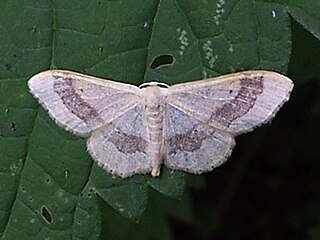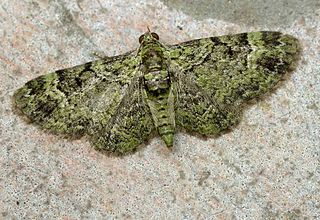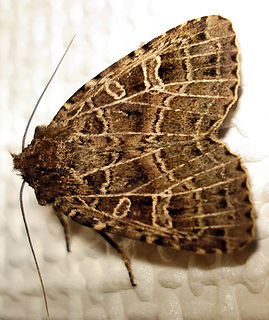
The riband wave is a moth of the family Geometridae. The species was first described by Carl Linnaeus in his 1758 10th edition of Systema Naturae.

The green pug is a moth of the family Geometridae. It is sometimes placed in the genus Chloroclystis or Rhinoprora. It is common throughout the Palearctic region and the Near East, but also appears in North America.

The latticed heath is a moth of the family Geometridae, belonging to the subfamily Ennominae, placed in the tribe Macariini. The genus was erected by Carl Linnaeus in his 1758 10th edition of Systema Naturae.

The common white wave is a moth of the family Geometridae. The species was first described by Carl Linnaeus in his 1758 10th edition of Systema Naturae. It is found throughout the Palearctic region .The habitat is deciduous forests and their surroundings.

The coxcomb prominent is a moth of the family Notodontidae. It is a common species throughout the Palearctic realm from Ireland to Japan. It was first described by Carl Linnaeus in his 1758 10th edition of Systema Naturae.

The brimstone moth is a moth of the family Geometridae. The species was first described by Carl Linnaeus in his 1758 10th edition of Systema Naturae. It should not be confused with the brimstone butterfly Gonepteryx rhamni.

The Gothic is a moth of the family Noctuidae. The species was first described by Carl Linnaeus in his 1758 10th edition of Systema Naturae. It is distributed in temperate Eurasia, in the Palearctic realm, including Europe, Turkey, Iran, Caucasus, Armenia, Transcaucasia, Central Asia, Altai mountains, and west and central Siberia.

The bright-line brown-eye is a moth of the family Noctuidae. The species was first described by Carl Linnaeus in his 1758 10th edition of Systema Naturae. It is a common species throughout Europe, but is also found in North Africa, temperate North Asia and Central Asia, Asia Minor, Syria, and Turkestan, northern India, China, Korea and Japan.

The copper underwing, humped green fruitworm or pyramidal green fruitworm is a moth of the family Noctuidae. The species was first described by Carl Linnaeus in his 1758 10th edition of Systema Naturae.

The small angle shades is a moth of the family Noctuidae. It is distributed throughout the Palearctic. The species was first described by Carl Linnaeus in his 1758 10th edition of Systema Naturae.

The angle shades is a moth of the family Noctuidae. The species was first described by Carl Linnaeus in his 1758 10th edition of Systema Naturae. It is distributed throughout Europe as far east as the Urals and also in the Azores, in Algeria, and in Asia Minor, Armenia, and Syria. It is strongly migratory.

The spruce carpet is a moth in the family Geometridae. The species was first described by Alfred Jefferis Turner in 1925. It is a double-brooded species, meaning it has two broods in one year. Its wings are coloured with different shades of grey, but the spring brood tends to have more brown colours.

Daphnis nerii, the oleander hawk-moth or army green moth, is a moth of the family Sphingidae. It was described by Carl Linnaeus in his 1758 10th edition of Systema Naturae.

Camptogramma bilineata, the yellow shell, is a moth of the family Geometridae. The species was first described by Carl Linnaeus in his 1758 10th edition of Systema Naturae. It can be found in Europe and east across the Palearctic to the Altai Mountains.

Cyclophora punctaria, the maiden's blush, is a moth of the family Geometridae. The species was first described by Carl Linnaeus in his 1758 10th edition of Systema Naturae. The species is mainly prevalent in Central and Eastern Europe. In the north, its distribution extends to southern Fennoscandia and the British Isles, in the west via France to parts of northern Spain, in the south via Italy, the Balkan Peninsula to Asia Minor. The eastern border of the distribution is roughly the Ural. In the Caucasus area, the nominate subspecies is replaced by the subspecies C. punctaria fritzae. The range of this subspecies extends as far as Iran.Cyclophora punctaria is found mainly in wooded areas with oak scrub and oak forests. In Central Europe it rises up to 700 metres in the hills, rarely up to 1,200 metres in the Alps, and regularly rises to 1,300 metres in southern Europe.

Thera is a genus of moths of the family Geometridae erected by James Francis Stephens in 1831.

Thera obeliscata, the grey pine carpet, is a moth of the family Geometridae. It is found throughout north and central Europe and east across the Palearctic to Siberia, and south to the Caucasus and Transcaucasia. In the Alps it can be found at an altitude of over 1500 metres.

Actebia praecox, the Portland moth, is a moth of the family Noctuidae. The species was first described by Carl Linnaeus in his 1758 10th edition of Systema Naturae. It is found in northern and central Europe, the Caucasus, central Asia, Siberia, Kamchatka, Sakhalin, the Kuriles, northern Turkey, Mongolia, China, Korea and Japan.

Chlorissa viridata, the small grass emerald, is a moth of the family Geometridae. The species was first described by Carl Linnaeus in his 1758 10th edition of Systema Naturae. It is found from western Europe to the eastern Palearctic.



















